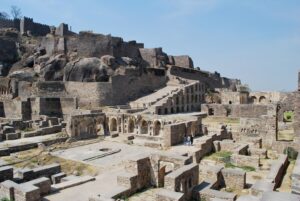Golconda Monuments

The Golconda Monuments, located in Hyderabad, Telangana, are a group of impressive structures that showcase the grandeur of medieval Deccan architecture. These monuments, primarily Golconda Fort, are renowned for their ingenious engineering, stunning architecture, and historical importance.
Architectural Features and Construction:
- Golconda Fort: Originally built in the 12th century by the Kakatiya dynasty and later expanded by the Qutb Shahi kings, Golconda Fort is a massive fortress complex spanning 11 kilometers of outer wall. It features robust bastions, intricately designed gateways, and numerous buildings within its precincts.
- Acoustical Marvels: One of the most fascinating aspects of Golconda Fort is its acoustical engineering. A hand clap at the entrance dome can be heard clearly at the highest point of the pavilion, over a kilometer away. This feature was likely used for communication and security.
- Water Supply System: The fort boasts an advanced water supply system, with Persian-style gardens and reservoirs ensuring a constant water supply. The system used a network of aqueducts and clay pipes, demonstrating the advanced hydro-engineering skills of the period.
- Architectural Style: The Golconda Monuments exhibit a blend of Hindu and Muslim architectural styles, featuring grand arches, domes, minarets, and intricate stucco work. The buildings within the fort, including palaces, mosques, and halls, display elaborate carvings and tile work.
Innovations and Engineering Techniques:
- Fortification: Golconda Fort’s fortifications include massive granite walls, some reaching heights of 12 meters, and numerous bastions equipped with cannons. The fort’s design incorporates concentric layers of defense, with a series of gates designed to impede invaders.
- Ventilation and Climate Control: The buildings within Golconda Fort were designed with natural ventilation systems to provide relief from the hot Deccan climate. High ceilings, strategic window placements, and cross-ventilation techniques were employed to maintain cooler indoor temperatures.
- Advanced Military Architecture: The fort’s construction includes features like trap doors, secret tunnels, and elevated vantage points, all of which were designed for strategic military advantage. The complex layout helped in defending against sieges and invasions.
- Palatial Residences: The inner citadel of Golconda Fort houses the royal palaces, such as the Taramati Mosque and the Durbar Hall, which were the seat of the Qutb Shahi rulers. These structures are adorned with intricate stucco decorations, beautiful frescoes, and ornate balconies.
Trivia and Lesser-Known Facts:
- The Golconda Fort is associated with the famed Koh-i-Noor diamond, which was believed to have been found in the region’s mines and stored in the fort’s vaults.
- The fort complex includes the tombs of the Qutb Shahi kings, located about 2 kilometers away. These tombs are grand mausoleums with distinctive onion domes and intricate carvings.
- The fort’s Fateh Darwaza (Victory Gate) still bears cannonball marks from its history of battles and sieges.
- The Golconda Fort served as the capital of the Qutb Shahi dynasty until it fell to Mughal Emperor Aurangzeb in 1687 after a prolonged siege.